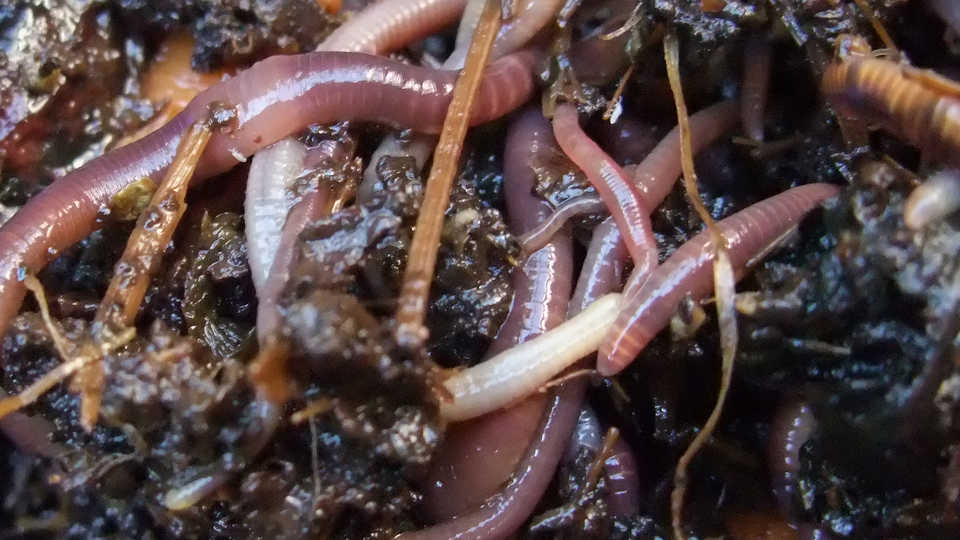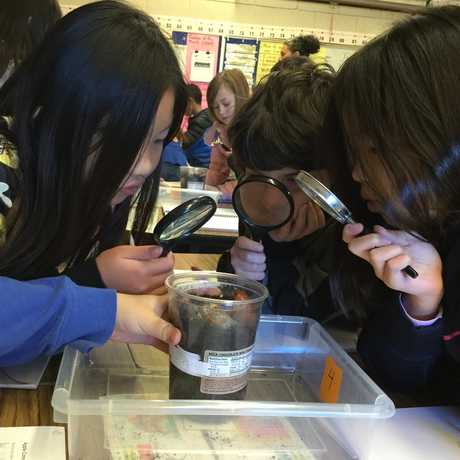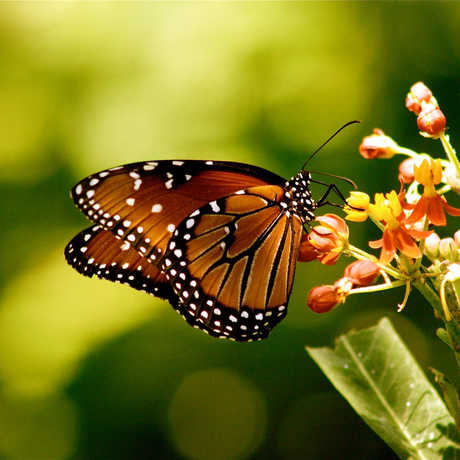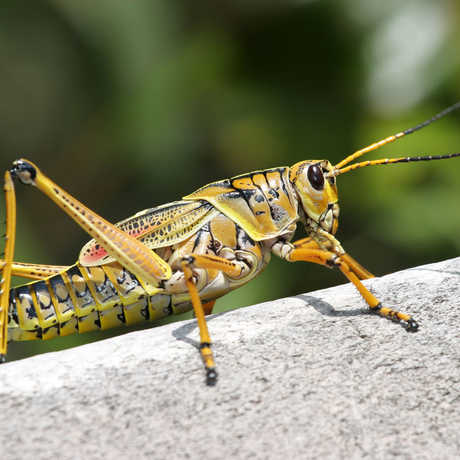
"Earthworms!" © 2009 Yun Huang Yong
Let’s construct a home for macroinvertebrates! Third graders observe the manor discovering which organisms can survive well and how they change when their environment changes. Fifth graders develop a model to describe the manor and the movement of matter among the plants, animals, decomposers and the environment. This project is designed to span a month or longer.
In this activity, students will:
- model the movement of matter among plants, animals, decomposers and the environment.
- observe some macroinvertebrates will survive well, while others will survive less well.
- cite evidence from their observations and graphs to support their reasoning.
- An outdoor space no smaller than one square yard (3ft. by 3 ft.) It can be loose soil or a paved area.
- If designated area is paved, 4 flower pots, diameter no smaller than 12 inches
- Soil
- Grass seeds (e.g., cat grass, oats, wheat, etc.)
- Several pieces of untreated (no pesticides or preservatives) wood about 6-12 inches long (e.g., sticks, off-cuts of building wood, firewood, etc.)
- Pieces of broken pavement, bricks, rocks or ceramic tiles
- Large potato (see activity for when this is needed.)
- Material that absorbs moisture well, such as heavy cotton, a carpet tile or carpet off-cut (see activity for when this is needed.)
- Optional: Clear jars or containers to use as bug boxes, paintbrushes and magnifying glasses.
SCRAP in San Francisco often has items needed for this activity including bricks, tiles, carpet remnants, etc.
- adaptation: any structure or behavior of an organism that improves its chances for survival.
- biodiversity: Bio=biological. Diversity=a variety of things. An area with many types of living things has high biodiversity.
- environment: everything living or non-living that surrounds and influences an organism.
- habitat: a place where plants and animals live.
- macroinvertebrates: Macro=big. Invertebrate = an animal which does not have a backbone. An animal without a backbone that you can see without using a microscope. This includes snails, slugs, insects, worms, spiders, and more.
Find an area near the school to place your ‘Macroinvertebrate Manor.’ It does not need to be large, even a square yard will do nicely. An ideal place will have the following:
- Quiet, away from human traffic areas
- Damp, close to growing plants or areas of cover
- Flowers nearby
- Light soil, not heavy clay
- What do you think lives in our school yard? Make a list of their ideas.
- Introduce students to the term macroinvertebrate and then share some fun facts about macroinvertebrates. Decide which ones on your list might be macroinvertebrates. Teacher tip: Students often have the misconception that salamanders, snakes and lizards are invertebrates. Showing images of these animals’ skeletons can show that they are vertebrates.
- Why would scientists study macroinvertebrates? Brainstorm some ideas on what scientists might learn about a place by studying macroinvertebrates.
- Grade 3: As scientists, we are going to go out to see what is currently living in a small patch of our school yard. Then we’ll make some changes to the environment in our school yard and see if we find different, more, or fewer macroinvertebrates in that same patch. This process is going to take a month or longer.
Grade 5: As scientists, we are going to make a special home for macroinvertebrates and then we will study the movement of matter among the plants, animals, decomposers and the environment within the home. This process will take a month or longer.
- Why might we want to give macroinvertebrates a special home in our school yard? Answers may include pollination, decomposition, soil aeration, and to be food for other animals.
- What makes a good macroinvertebrate home? Students may suggest a variety of habitats, different food sources, places to shelter, temperatures, and moisture levels.
*required for Grade 3 standards, can also be done by Grade 5
- Take students into the school yard with their science notebooks or paper on a clipboard. Have them sit down and silently watch the area for 3-5 minutes, drawing or noting any macroinvertebrates they see in or flying past their area. Also take note of any other animals or plants in the area.
- After passively observing, students can investigate the area close up and use their pencils to lift up any rocks, leaf litter or sticks to see what is hiding underneath. The focus isn’t on knowing exactly what a creature is but they should be able to describe it.
- Back in the classroom, in small groups, construct a list of the macroinvertebrates you all found, including example drawings or pictures if you have them. If you found none, let the students know that a null result is also valuable. Also have students describe the environment where the macroinvertebrates were found.
Divide students into groups, so that each is assigned an environment. While one group works to create their assigned environment, the other groups can create signs for their environment, draw the area as it looked before the manor was made, and draw the initial state of the manor. Create 4 separate environments either by sectioning the ground space or having one flower pot for each environment. Each environment space should be at least 16 inches by 16 inches or in a pot with a minimum diameter of 12 inches.
- Grassy Patch: Plant grass seeds in soil or keep the grass of your chosen area. The grass should be kept longer with about 4 inches of growth. If planting grass seeds, remember to help them to grow by watering as needed.
- Bare Soil: Turn the soil in the pot or ground area with a shovel to prevent the soil from being compacted, as if preparing to plant seeds.
- Log Pile: Stack several pieces of untreated wood in a pile. Choose pieces of wood that fit within the space or flower pot. Bundle several pieces together with twine or string leaving gaps between the pieces to allow macroinvertebrates to crawl into the spaces. Place the log pile directly on the bare soil.
- Stone Stack: Create a solid base of stones directly on the bare soil. Loosely stack stones, broken bricks or bits of broken paving slab on the base of rocks. Leave plenty of small spaces between the pieces to allow macroinvertebrates entry.
Macroinvertebrate Manor Maintenance
Macroinvertebrates need a moist environment, so keep the soil in each space damp without soaking it, about the wetness of a wrung out sponge. For the Grassy Patch, remember to cut the grass occasionally and keep it close to 4 inches long. Disperse the cuttings on the ground in the grassy patch. There is no need to remove weeds from most of the areas unless it prevents macroinvertebrate observation. In fact, different plants may attract different macroinvertebrates. The Bare Soil area should be kept clear except for small amounts of vegetation that is different from grass (i.e., flowers, moss, seedlings, etc.).
After the Manor has had about 2 weeks to establish, you and your students may find some new macroinvertebrates! Follow these tips to make the most of your visits to the Manor.
Macroinvertebrate Manners:
- Students must care for their macroinvertebrates and try to not harm or kill them while studying them.
- Remember to remove logs and stones carefully to protect the creatures underneath.
- Try not to disturb them too frequently; maintaining and studying the manor once a week is ideal.
- Keep the soil moist and area clear of trash.
- To keep students safe, provide a bug box to put macroinvertebrates in for observation. Small jars with lids make fantastic bug boxes. Remember to return the macroinvertebrates to the manor or they will not survive.
- Use a utensil such as a shovel or stick when raising the rocks and wood for observation to protect students from dangers such as stinging insects.
- Paint brushes make great barriers for students who do not want to touch the macroinvertebrates. The bristles are gentle enough to push macroinvertebrates around and into bug boxes without hurting the creatures.
Catch a creature in a Potato Trap
- Cut a large potato in half lengthwise, scoop out some of the inside of the potato with a spoon, and close the potato.
- With a knife, bore a hole in one side of the potato to let macroinvertebrates enter.
- Bury the potato trap about a half inch deep in the Bare Soil area of your Macroinvertebrate Manor and leave it alone for several days.
- Lift the top half of the potato out of the soil and observe and record the macroinvertebrates found. Students may collect the animals found in a clear container for closer observation. After observation, return the trap lid (and its residents) to the soil.
Who likes the Wet?
- Take either a stack of 5 or more layers of fabric, a carpet tile, or carpet off-cut and soak thoroughly with water.
- Place the fabric on the ground in a cool, shady area of your Macroinvertebrate Manor, and put stones on the corners of the fabric to keep it in place. Keep it moist for 3 days.
- In the morning, lift it up to discover what is hiding. Use bug boxes and magnifying glasses to more closely examine the residents. After observation, replace it on the ground.
Check the Manor Regularly:
Observe each of the manor’s spaces to see the biodiversity of macroinvertebrates in each environment. Keep a record of all the macroinvertebrates, including what type and in which environment they were found in a journal or chart. These records will help you decide if you have a new inhabitant.
Grade 3: Have the students keep track of the date and which macroinvertebrates they notice in the manor in their science notebooks. Weather can be a factor in who you find, so encourage students to keep notes about that too. It may be easier to have different groups focus on different sections of the manor.
Grade 5: In order to better understand the movement of matter in the manor, have the students try to figure out why type of macroinvertebrates they have using a field guide. Students can do research to determine if their macroinvertebrates are predators, decomposers, or herbivores. They can then work to determine which way the matter in the macroinvertebrate manor is moving. To simplify things, try assigning different sections of the manor to different groups.
- Review which macroinvertebrates have become residents in the Manor. Note which residents are in the Manor during different weather patterns.
- Discuss which types of macroinvertebrates prefer which environment and why they might have these preferences.
- Compare the biodiversity of the four environments.
- Study the areas during different seasons to determine if the variety of macroinvertebrates changes with the seasons.
- Grade 3: Using their notes, compare the environment and inhabitants of the Manor before and after it was built. Focus the students on the small space just where the Manor was built.
- Grade 3: Have students write or discuss which macroinvertebrates were able to persist in the habitat, which ones moved away and which ones moved in. If they persisted, did the numbers increase or decrease? Have students use evidence from their notes to support their choices.
- Grade 5: Have student groups create a model of the movement of matter within the manor environment. Have groups compare their models and discuss the merits of their choices.
- Record Observations in a scientific journal: Document the Macroinvertebrate Manor project.
- Write down information about the location of the manor and why it was chosen, such as temperature, sunlight, human traffic, etc.
- Explain the procedure taken to create the manor including dimensions, layout and creation of the 4 environments. Perhaps include ‘before’ and ‘after’ photographs to see the progress.
- Record when macroinvertebrates were first seen living in the manor. Classify what was found and in which environment.
- Follow up regularly with details of the manor’s residents through different weather patterns including sun, rain, heat, cold and seasonal changes.
- Create a Short Film: Explain the process of making Macroinvertebrate Manor, describe and display the residents of the environments or narrate a day in a macroinvertebrates’ life.
Please see the lesson Macroinvertebrate Manor Extensions for ways to extend this activity!
Why do we want to give macroinvertebrates a home?
Providing a habitat for local species to live and raise young can help to protect the biodiversity of your neighborhood. Some macroinvertebrates include:
- insects (bees, caterpillars and butterflies, beetles, flies, ants, grasshoppers, etc.)
- arachnids (spiders, mites, ticks, scorpions, harvestmen, etc.)
- centipedes and millipedes
- crustaceans (woodlice, pillbugs, etc.)
- mollusks (snails and slugs)
- worms (earthworms, roundworms, etc.)
What makes a good home for macroinvertebrates?
Macroinvertebrates live in many different types of habitats. Some prefer dark, damp places under cover, while others prefer a warm open area with flowers, grass and rocks for sunbathing. Some macroinvertebrates hibernate in the winter months while others are less active in warmer temperatures. Each species has its own ideal living conditions but every environment is shared between multiple species.
General facts about invertebrates:
- 97% of all known species known to science are invertebrates, as much as 30 million species (Klappenbach, n.d.a). This is only a small fraction of what scientists believe are left to be discovered.
- Invertebrates were the first animals to evolve from single-celled microorganisms. They evolved more than 500 million years ago (Klappenbach, n.d.b).
- There are more than 30 groups of animals classified as invertebrates including insects, echinoderms, spiders, sponges and mollusks (Klappenbach, n.d.b).
- There are more species of insects than there are species of all other animals combined (Klappenbach, n.d.e).
- Invertebrates are classified as ectotherms which means cold-blooded. They absorb heat from their environment rather than producing it themselves (Klappenbach, n.d.a).
- Most invertebrates go through metamorphosis (stages of development) (Klappenbach, n.d.b).
- 1 in 5 species of invertebrates is at risk of extinction (Borrell, 2012).
Interesting facts about specific invertebrates:
- Sponges have no digestive, circulatory or nervous systems (Klappenbach, n.d.c).
- The record for the world’s largest invertebrate is the Colossal Squid, which can weigh more than 1000 pounds and stretch to as long as 33 feet. It lives in the Southern Ocean around Antarctica (California Academy of Sciences, n.d.).
- Nematodes, or roundworms, are the most numerous animals on earth. Four out of every five animals on earth is a nematode. (Frazer, 2013)
- The leggiest animal on the planet lives just south of San Francisco. Illacme plenipes comes the closest to the description of a millipede than any of its relatives—females have as many as 750 legs! (Marek, Shear, & Bond, 2012)
Grade Three
Performance Expectations
- 3-LS4-3. Construct an argument with evidence that in a particular habitat some organisms can survive well, some survive less well, and some cannot survive at all.
- 3-LS4-4. Make a claim about the merit of a solution to a problem caused when the environment changes and the types of plants and animals that live there may change.
DCIs
- LS2.C: Ecosystem Dynamics, Functioning, and Resiliance
- LS4.A: Evidence of Common Ancestry and Diversity
- LS4.C: Adaptation
- LS4.D: Biodiversity and Humans
Grade Five
Performance Expectations
- 5-LS2-1. Develop a model to describe the movement of matter among plants, animals, decomposers, and the environment.
DCIs
- Interdependent Relationships in Ecosystems
- Borrell, B. (2012, September) One-Fifth of Invertebrate Species at Risk of Extinction. Nature. Retrieved November 21, 2013 from Nature http://dx.doi.org/10.1038/nature.2012.11341
- Frazer, J. (2013, February). Nematode Roundworms Own This Place. Scientific American Blogs. Retreived July 1, 2014 from http://blogs.scientificamerican.com/artful-amoeba/2013/02/09/parasitic-roundworms-own-this-place/
- Invertebrates. (n.d.) California Academy of Sciences. Retrieved November 21, 2013 from California Academy of Sciences Website http://www.calacademy.org/science/lifeforms/invertebrates/
- Klappenbach, L. (n.d. a) Invertebrates. About.com. Retrieved November 21, 2013 from http://animals.about.com/od/invertebrates/p/invertebrates.htm
- Klappenbach, L. (n.d. b) Facts About Invertebrates. About.com. Retrieved November 21, 2013 from http://animals.about.com/od/invertebrates/a/tenfactsinvertebrates.htm
- Klappenbach, L. (n.d. c) Sponges. About.com. Retrieved November 21, 2013 from http://animals.about.com/od/sponge1/p/porifera.htm
- Klappenbach, L. (n.d. d) Arthropods. About.com. Retrieved November 21, 2013 from http://animals.about.com/od/arthropods/p/arthropoda.htm
- Klappenbach, L. (n.d. e) Insects. About.com. Retrieved November 21, 2013 from http://animals.about.com/od/insects/p/insects.htm
- Marek, P., W. Shear, & J. Bond. (2012). A redescription of the leggiest animal, the millipede Illacme plenipes, with notes on its natural history and biogeography (Diplopoda, Siphonophorida, Siphonorhinidae). ZooKeys (241), 77-112.
- Image: "Earthworms!" by Yun Huang Yong, licensed and modified under CC BY 2.0, originally sourced from https://www.flickr.com/photos/goosmurf/3828755105


